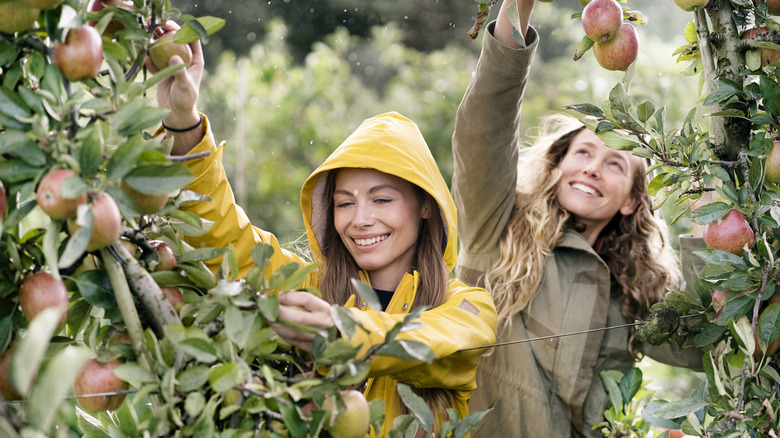How To Prepare Your Soil Before Planting Fruit Trees
If you want to invest in planting fruit trees in hopes of a harvest, one of the most important things to understand is how to prep your soil ahead of time. That starts with understanding how excessive water can negatively affect your fruit tree's growth. While there are fruit trees that grow in hot and dry climates, most fruit trees will die in any environment where the soil is too damp. That's why farmers use large farm equipment to employ soil aeration — a method where oxygen is moved around in the earth in an attempt to lower the carbon dioxide present in the soil — which is a necessity to overcome the consequences of excessive moisture.
There are a few causes of oxygen-starved soil, but the most common problem for the average homeowner (not living on a farm) is likely waterlogged soil. When soil is oversaturated as a result of heavy rainfall or over irrigating, air pockets in the earth become full of water. So, the roots of your fruit trees are left without life-giving oxygen. Since the roots are how your fruit trees absorb nutrients in the earth, your fruit trees stand little to no chance of survival. Aside from the lack of oxygen, too much water can also lead to fungal diseases, such as anthracnose, which attacks the leaves of trees, peach leaf curl, which affects the fruit growing on peach and nectarine trees, as well as several different types of blight.
Ensure your fruit trees 'feel the berm' to avoid oversaturation
Making sure that your soil is properly aerated can be achieved by berm your soil before planting your trees. To berm means raising the soil in specific areas of your garden where you plan to plant your fruit trees. Unlike how to start a raised garden bed, soil that has undergone berming should be rounded, not flat and rectangular. Due to the rounded formation and gradual slope of the berm, rainwater won't be directed away from the roots of your fruit tree, but it still allows for optimal drainage. Be sure that your berm is raised at least a foot, while not going much higher than two feet, and increase the width by five feet for every foot of soil elevation.
To avoid hitting any utility lines before reaching for your shovel, contact 811, a free national resource that will send professionals from utility companies to mark their underground lines before you start digging. Once you've ensured your shovel won't hit any utility lines, arrange a garden hose in the shape of your berm and trace it with flour. Gradually build up a wall of topsoil around the circle using the flour as a guide, but make sure it's at least a foot from the trunk of your fruit tree. Ultimately, building a berm is one of those things you should consider before planting a fruit tree in your backyard.
Opt for moisture-tolerant trees
Some fruit trees and wetland plants have evolved to survive with less oxygen because their roots are closer to the surface. These roots, called pneumatophores — meaning air carrier in Greek — act like underwater breathing apparatus for these specific trees, allowing their roots to collect oxygen even in oversaturated conditions. Think about planting fruit trees that you know can withstand heavy rain, or at least survive growing in very wet soil for a short period. Failing to do a little research in this department is one of the common mistakes everyone makes when planting fruit trees. A particular group of fruit trees that thrive in wet soil include apple trees, such as Fuji, Gala, Anna, and Beverly Hills apples. Asian pears and persimmons are also examples of fruit trees that can withstand long periods of wetness. Fruit trees that can handle damp soil for shorter periods include bananas, limes, and lychees. Mangrove trees, typically found in wetland regions, do very well in wet soil.
Prefer the idea of a berm for your choice of fruit tree? You can diversify the look of your garden by planting other berm-friendly trees, like Hibiscus syriacus, otherwise known as Rose of Sharon. Rose of Sharon blooms flowers of various shades — deep pink, white, or violet — depending on the specific variety of tree. Rose of Sharon is so easy-growing it's considered an invasive species in states like Kentucky, Pennsylvania, Tennessee and Virginia. However, it prefers both sunshine and shade, and does not require fertilizer. Ornamental grasses are another option as they help to keep your burm intact.


